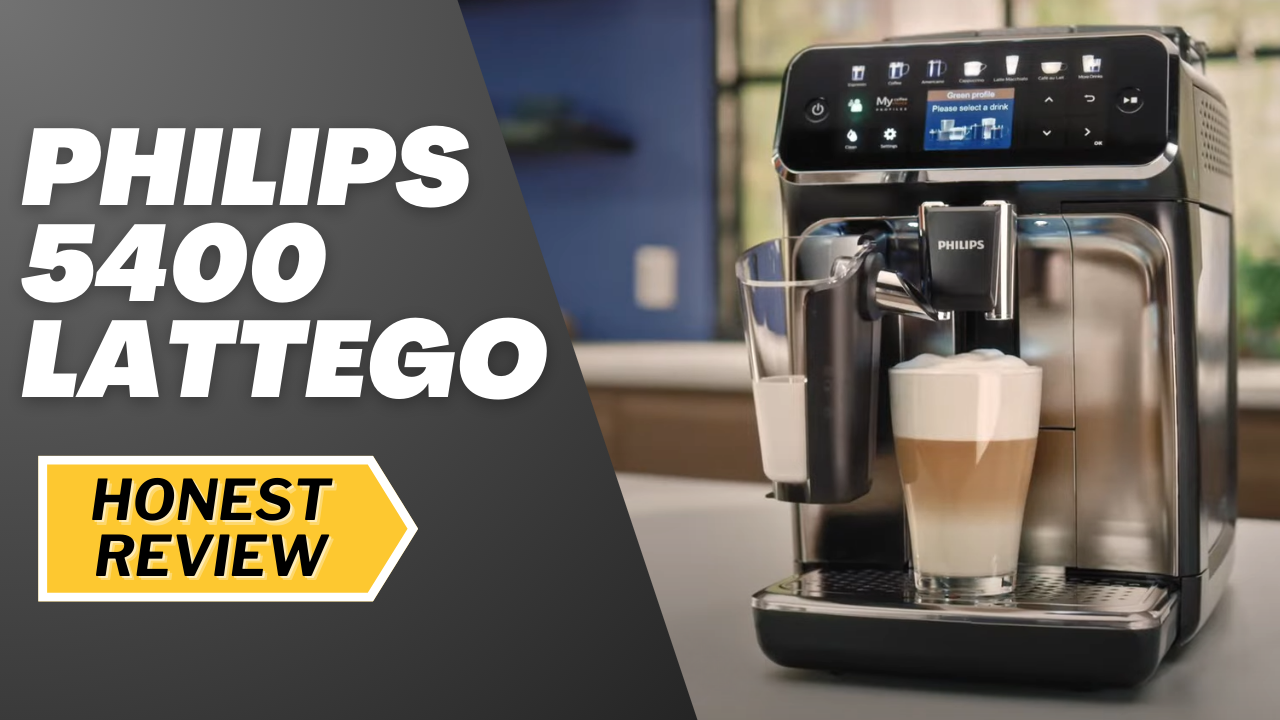Quick Answer: I only recommend the Philips 5400 LatteGo if you’re going to make full use of its four user profiles. If you don’t think you’ll do this, then you’re better off with the cheaper Philips 4300 LatteGo.
The Philips 5400 LatteGo is Philips’s most premium fully automatic espresso machine. It’s Philips’s only machine that typically retails for over $1,000.
In this Philips 5400 LatteGo review, I’m going to explain why I don’t think the coffee machine justifies its large price tag for the majority of people. And I’ll explain exactly who I think the machine is good value for (large households and offices, in a nutshell).
I’ll also assess the espresso machine more generally, telling you what I like and don’t like about it.
Let’s go.
Should I Buy the Philips 5400 LatteGo?
I’d only recommend the Philips 5400 LatteGo if you’re buying a coffee machine for a large household of people who drink milk-based espresso drinks, or for an office where you want easy one-touch lattes.
The Philips 5400 LatteGo’s main strong points are:
Its four user profiles allow lots of different people to make a coffee to their ideal drink preferences with just a couple of button presses.
It lacks messiness compared to other fully automatic espresso machines.
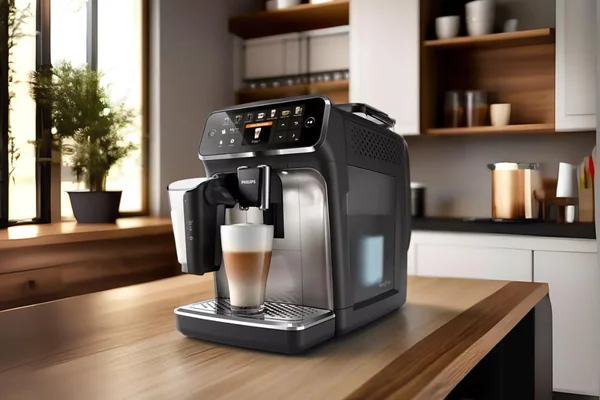
Philips 5400 LatteGo
The Philips 5400 LatteGo’s four user profiles and ease of cleaning make it the ideal coffee machine for larger households or offices.
If you are not going to make full use of the Philips 5400 LatteGo’s user profiles, then instead get the Philips 4300 LatteGo.
The Philips 4300 LatteGo has the exact same brewing and milk frothing system, as well as the same user interface as the 5400.
The 4300 just has two user profiles instead of four and lacks a few of the Philips 5400’s menu items. You can recreate the Philips 5400’s additional menu items with the 4300 by playing around with its coffee strength and size settings.
The Philips 4300 LatteGo is typically around $200 cheaper than the Philips 5400 LatteGo.
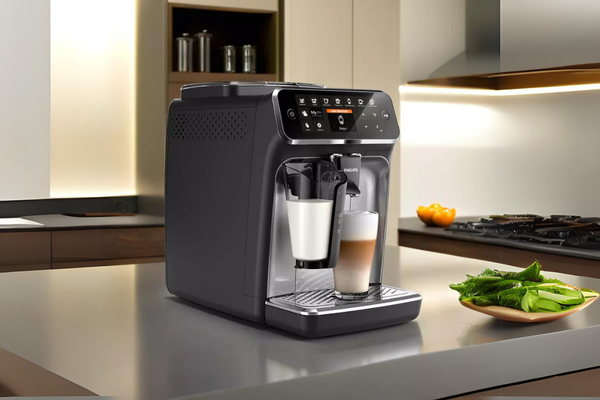
Philips 4300 LatteGo
The Philips 4300 LatteGo is significantly cheaper than the 5400 LatteGo and is pretty much the same as it minus a couple of user profiles.
All Philips super-automatic espresso machines make watery espresso.
If you will primarily drink plain espresso then I’d recommend the Delonghi Dinamica over the Philips 5400 LatteGo
The Delonghi Dinamica makes better-tasting espresso (and better-textured milk foam, for that matter) than the Philips 5400 LatteGo.
It’s more expensive than the Philips 5400 LatteGo, and harder to use and keep clean.
These latter factors might make it less suitable for an office.
For more information on how Philips and Delonghi coffee machines compare please see my comparison on the Philips 5400 vs. Delonghi Dinamica.
Philips 5400 LatteGo: Performance Ratings
| Category | Rating | Comments |
|---|---|---|
| Espresso Quality | ★★★☆☆ (5/10) | Decent, but lacks body compared to Delonghi models. |
| Milk Frothing Performance | ★★★★☆ (7/10) | Thick, consistent froth, but lacks variety in texture. |
| Ease of Use | ★★★★★ (10/10) | User-friendly, intuitive controls with a TFT display. |
| Ease of Cleaning | ★★★★★ (10/10) | Dishwasher-safe parts and no messy milk tubes. |
| Design & Durability | ★★★☆☆ (6/10) | Plasticky build, concerns about long-term durability. |
| Value for Money | ★★★☆☆ (6/10) | Great features at an affordable price. |
REASONS TO BUY
- Its four user profiles can be useful if a lot of you are going to be using the espresso machine and you all have different preferences.
- Its milk frother is easier to clean than those found on Jura and Delonghi machines.
- It’s easier to customize your drinks with than a similarly priced Delonghi espresso machine.
REASONS TO AVOID
- It’s overpriced if you’re not going to make full use of its four user profiles.
- You have no real control over its milk texture.
- Its grinder has a tendency to clog up.
Philips 5400 LatteGo: Machine Overview
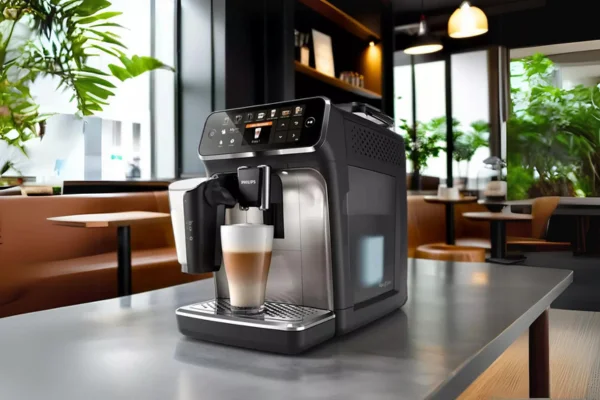
The Philips 5400 LatteGo is a super-automatic espresso machine.
This means that all you need to do is fill the machine up with whole coffee beans and water. The machine will grind, tamp, and brew your espresso for you.
The machine steams milk with an automatic milk frother. This is a plastic container with a spout that attaches to the machine.
You can take this milk frother apart into three pieces and put it in the dishwasher (most automatic milk frothers aren’t this easy to clean).
See on Philips 5400 AmazonPhilips 5400 LatteGo: Key Features
| Specification | Philips 5400 LatteGo |
|---|---|
| Description | Super-automatic espresso machine with milk frother |
| Milk system | Detachable carafe (no rubber tubing) |
| User Interface | Button operated TFT screen |
| User Profiles | 4 + guest profile |
| Number of available black drinks | 7 |
| Number of available milk drinks | 6 |
| Strength settings (per drink) | 5 |
| Size settings (per drink) | 5 |
| Milk size settings (per drink) | 5 |
| Milk texture settings | 1 |
| Double shot button | Yes |
| Grinder Type | Ceramic flat burr grinder |
| Grind Size Settings | 12 |
| Removable brew group | Yes |
| Mug Clearance | 3.3″ – 5.8″ |
| Dimensions (width x depth x height) | 9.7″ W x 17.0″ D x 14.6″ H |
Initial Set Up
The Philips 5400 LatteGo runs a rinse cycle and makes you run a water hardness test when you first start it up.
This initial rinse is very noisy (I actually thought the coffee machine was breaking down when this was happening).
Make sure you have a cup under the machine’s spouts (both milk and coffee spouts) as it’s hot and will be ejected out of here during the initial rinse.
The espresso machine comes with a water hardness test strip. Its display screen runs you through how to take this test so it’s very easy.
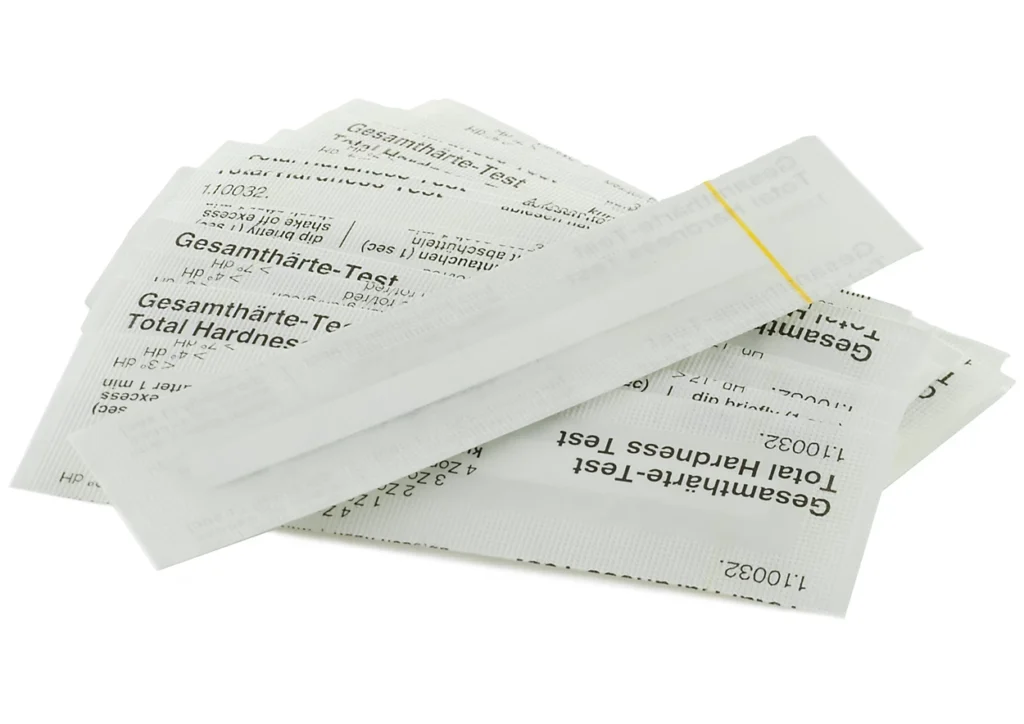
The result of this water hardness test determines how often the machine will ask you to descale it.
Once the espresso machine has run a rinse cycle and you’ve inputted your water hardness you can get brewing.
User Interface
The Philips 5400 LatteGo uses a button-controlled TFT screen control panel. Its user interface is one of the machine’s high points.
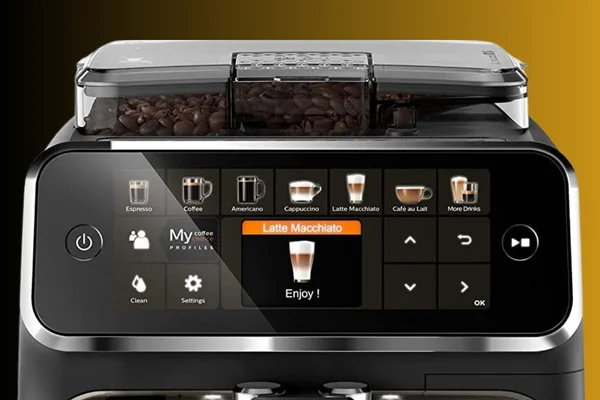
I love the Philips 5400’s user interface. I think it is superior to any super automatic in the $1,000 – $1,500 price range for three reasons:
- All instructions are in plain English: This compares favorably to a lot of machines that use cryptic icons and symbols to give you instructions.
- Its buttons are more reliable than a touch screen: I like that the Philips’s control panel is operated with buttons rather than a touch screen. I think that iPhones have made all other touch screen-operated user interfaces seem jumpy or unresponsive in comparison. You’re far more likely to make a mistake using the Delonghi Dinamica Plus’s touch screen than you are with the Philips 5400 LatteGo’s buttons.
- Its menu has a picture of each drink as well as its name: This makes choosing a drink easier than machines that rely on icons that barely look like the drink they represent.
Philips makes the most user-friendly fully automatic coffee machines, and their machines’ user interface is a big factor behind this.
See on Philips 5400 AmazonDrink Options
The Philips 5400 LatteGo can make 12 coffee drinks. They are:
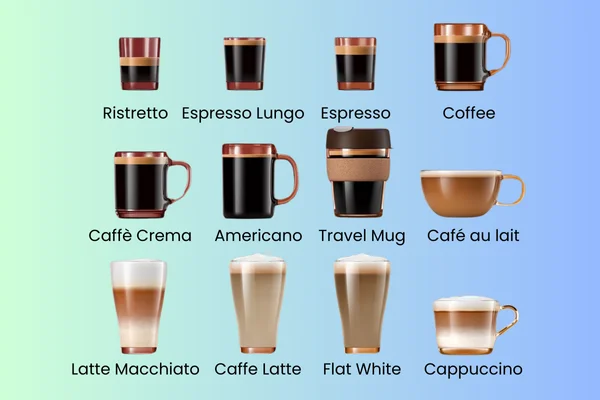
- Espresso: Not amazing. It has a decent flavor but it’s lacking in body. You get the best results if you grind as fine as possible and max out its strength and brewing temperature. Even then it’s not as good as what you’d get from a Delonghi super automatic. Still better than Nespresso. 5/10
- Coffee: Much better than its espresso (ironically, for an espresso machine). It’s not far off what you’d get from a good-quality drip coffee machine. 7/10
- Americano: This is the machine’s worst drink. It makes a proper Americano in the sense that it’s an espresso topped with a squirt of hot water but this just waters down an already watery espresso. Avoid. 3/10
- Cappuccino: Decent after a light stir. It froths milk to a very thick consistency so it doesn’t properly integrate with your coffee until you give it a stir. Don’t stir it too hard or a lot of its milk foam texture will disappear. 5/10
- Latte macchiato: One of its best drinks. The machine dispenses your milk foam, then pauses to let it settle a bit, then dispenses your coffee. This makes the milk and coffee incorporate a bit better and creates a cool layering effect. 8/10
- Caffe latte: The machine’s other best drink. It dispenses your coffee before your milk (unlike the cappuccino). Your milk foam incorporates with your coffee a lot better than with a cappuccino. Its coffee flavor is stronger than with the latte macchiato. 8/10
- Flat white: This was just the cappuccino but with less milk foam. Again you need to give it a light stir for the coffee and milk to integrate. 5/10
- Café au lait: This is the machine’s coffee with a bit of milk foam. It’s a bit weird. I just stir it until all the milk’s texture disappears instead of adding cold milk to a coffee. 6/10
- Cafe Crema: This is a black coffee drink that seems to just be an espresso but brewed with extra hot water. It tasted halfway between an espresso and Americano – weak, in other words. 4/10
- Espresso Lungo: This seems to be identical to the cafe crema. Brewing with extra hot water just makes your espresso even waker. 4/10
- Ristretto: Smaller and sharper than the espresso. I think there is not enough water to get a good extraction here. 4/10
- ToGo Mug: This is just its coffee but bigger. 7/10
The machine also dispenses plain milk foam.
The main takeaway here is that the Philips 5400 LatteGo’s milk-based coffee drinks are better than its black coffee drinks.
Its latte and latte macchiato are its highlights.
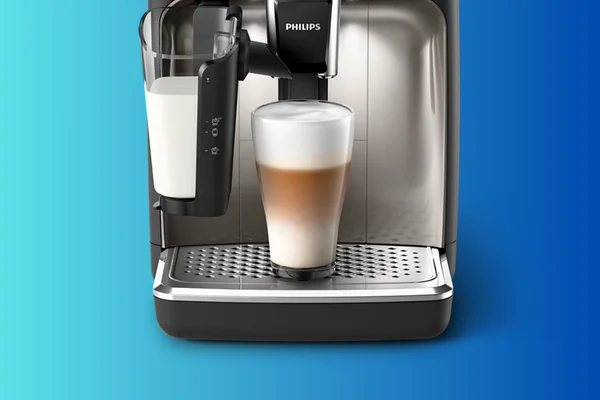
This is why I recommend Delonghi Dinamica over the Philips 5400 LatteGo to people who primarily want a machine for plain espresso.
Drink Customizations
The Philips 5400 LatteGo lets you customize your drink’s size and strength at just the touch of a button.
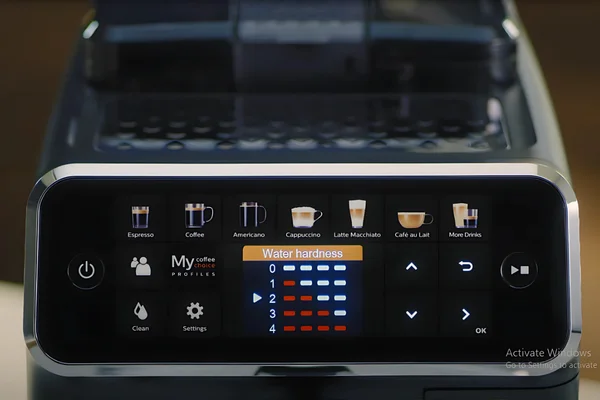
The Phillips 5400 lets you customize the following:
- Coffee volume: These exact volumes offered vary from drink to drink. You have five settings per drink.
- Coffee strength: This affects how much ground coffee is used in your drink. It’s a shame that it’s measured in arbitrary steps rather than by weight. Again, five settings per drink.
- Milk voluatteGo milk container attached and detached fromme: Like coffee volume the exact volumes offered vary from drink to drink. Five settings per drink. Non-milk drinks give you the option of making a double serving instead of this (double espresso, for example).
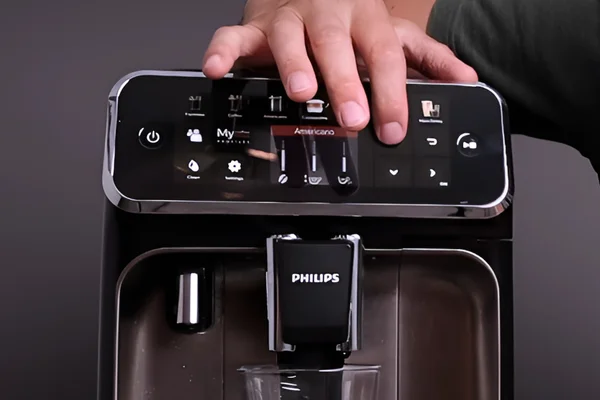
You can also change the machine’s brewing temperature. It has three temperature settings. I’d always recommend brewing at its highest water temperature.
I love how the Philips 5400 LatteGo lets you customize each drink just at the point where you’re about to make that drink.
A lot of other super-automatic espresso machines (especially Delonghis) require you to put the machine in a dedicated “customize mode” and then hard code each menu item.
This is a lot of unnecessary work for a very marginal gain in precision.
User Profiles
The Philips 5400 LatteGo gives you four user profiles plus a guest profile.
Whenever you customize a menu item you have the option of saving it to whatever user profile you’re on.
This way you can make your favorite drink with three button presses (select user profile, select drink, press brew). It also means that someone else isn’t going to overwrite your drink preferences.
The machine also has a guest profile where you won’t overwrite any saved settings.
Personally, I think it’s so easy to customize your coffee drinks that having all these user profiles isn’t necessary for most people.
These additional user profiles are the main difference between the Philips 5400 LatteGo and Philips 4300 LatteGo (the Philips 4300 LatteGo only has two user profiles).
I personally wouldn’t pay an extra ~$200 just to have two extra profiles. However, if you’re buying the machine for a large household or an office then this may be worth it.
If you also don’t think you’d benefit from paying extra for additional profiles then you might want to check out my Philips 4300 LatteGo review.
LatteGo Milk System
The Philips 5400 LatteGo’s milk system consists of a plastic carafe that can attach and detach from the machine. I love how it doesn’t use any rubber tubing.
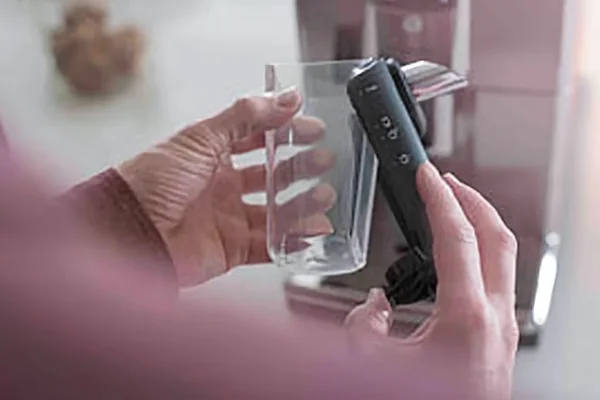
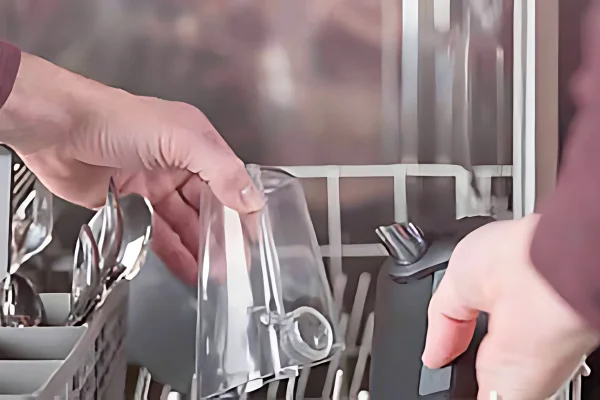
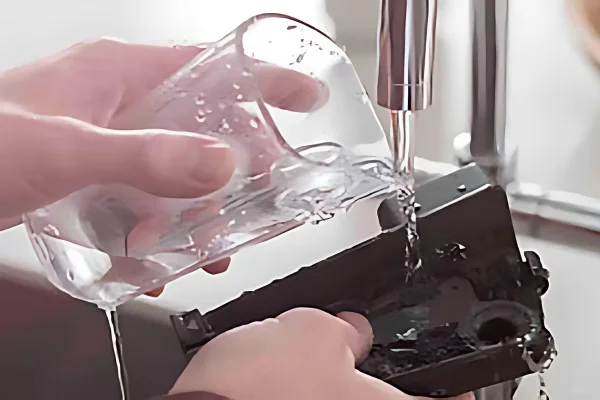
The LatteGo fully automatic milk frother can only steam your milk to one (very thick) texture. This makes all your milk drinks quite same.
The big advantage of the LatteGo milk system is how easy it is to clean.
It breaks apart into three pieces, all of which are dishwasher safe.
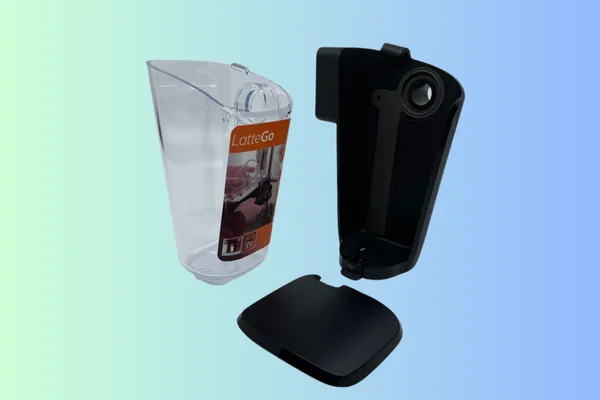
I LOVE how the LatteGo system doesn’t use any rubber tubes.
Rubber milk tubes drip milk everywhere and crust up with sour milk. They’re a nightmare to clean because their holes are so small.
The LatteGo milk system is the only fully automatic coffee machine milk frother that doesn’t rely on rubber tubes so it is by far the easiest of these to keep clean.
My one criticism of the LatteGo milk frother, as far as usability is concerned, is that its spout juts quite far away from your coffee spout. This makes it hard to get your coffee and your milk in your cup without moving it during dispensing.
I often had milk spilling down the front of my cup because it was pushed too far back.
The machine has a dedicated LatteGo system cleaning mode, but I still would clean the milk container by hand. If you only rely on the machine’s cleaning cycles then the milk container will develop a sour milk smell.
Ceramic Burr Grinder
The Philips 5400 LatteGo uses a ceramic flat burr grinder with 12 grind size settings. I’m concerned by how much steam rises through its grinder and bypass doser as this will likely cause clogging.
Philips fans like to brag that its use of a ceramic burr grinder instead of a stainless steel one means that it makes better espresso than most super-automatic espresso machines.
Personally, I’m not buying this.
A super automatics brewing unit makes a far bigger difference to its espresso quality than its grinder’s burr material. Philips super automatics makes inferior espresso to Delonghi and Jura super automatics despite the latter using stainless steel burr grinders.
The Philips 5400 LatteGo’s coffee grinder has 12 grind settings which you can adjust with a dial. It also has a bypass doser for pre-ground coffee.
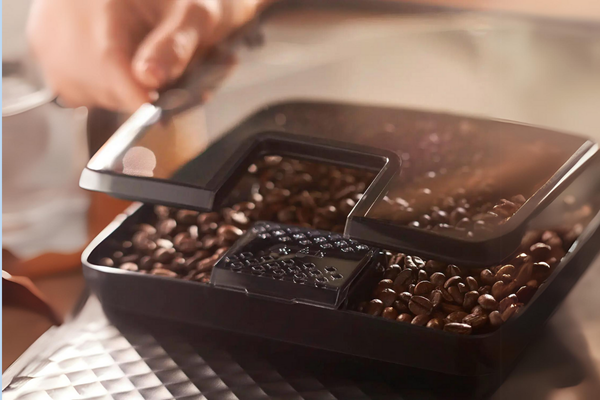
I do have one BIG concern about the machine’s grinder. When you brew you can see steam rising up through the grinder’s chute and condensation forming on its lid.
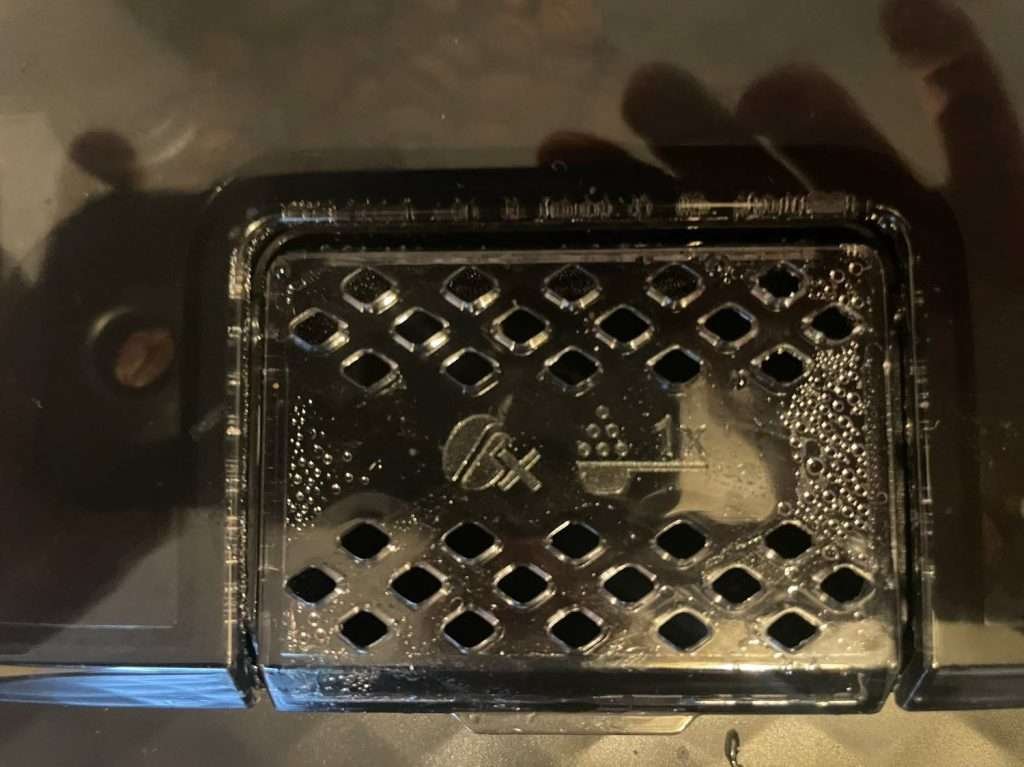
This moisture is bound to cause the coffee grinder to block up.
This happens so often that Philips themselves have made a video on how to unclog its grinder:
As you can see this is not a fun fix. I can see this happening a lot because of how much steam rises up through your grinder every time you brew.
Drip Tray
The Philips 5400 LatteGo’s drip tray is very flimsy and has a lot of plastic edges that you could easily cut yourself on.
I really don’t like removing and cleaning the Philips 5400 LatteGo’s drip tray.
It’s a super flimsy and cheap feeling. It has sharp plastic edges that you could potentially cut your hand on.
This isn’t good enough for a machine that costs over $1,000.
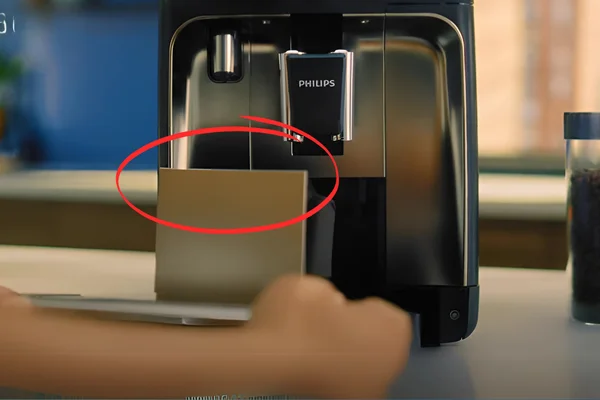
I also don’t like how its indicator float doesn’t actually rise to tell you when it’s full.
This makes flooding your drip tray way more likely, especially if you forget to put a cup underneath its spouts when it does its initial hot water rinse after it turns on.
Water Tank
The Philips 5400 LatteGo’s water tank pulls out from the front and is dishwasher safe.
These are my two requirements for a water tank to be good.
I also like how the drip tray has an open lid. This makes it easier to dry out after cleaning.
AquaClean Water Filter
The Philips 5400 LatteGo’s AquaClean water filter means that the machine only needs to be descaled after 5000 brews. You need to replace it every three months, however.
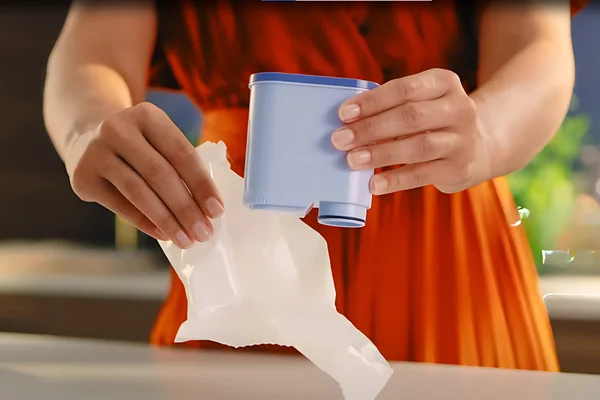
Needing to replace a water filter every three months is something you’ll find with every coffee machine.
The Philips 5400 LatteGo does need to be descaled less often than most coffee machines, which is nice.
Rinsing and Cleaning Modes
The Philips 5400 LatteGo rinses automatically when you turn it on. It also has a dedicated brew group and milk frother cleaning modes.
I personally don’t really trust these cleaning modes, and think that you should rinse the removable brew group manually and put the milk carafe in the dishwasher after you use it.
This is particularly true of the milk frother. If you don’t put it in the dishwasher it will form a faint (but noticeable) sour milk smell.
I like how the machine doesn’t go into random rinse cycles. Apart from its initial start-up rinse, all other rinse cycles need to be prompted manually.
This negates one of the biggest issues people have with a fully automatic coffee machine. Namely, you need to keep a cup under your spout because it’s constantly running rinse cycles (Delonghi machines are particularly bad for this).
Removable Brew Group
The Philips 5400 LatteGo’s brew group can be removed for cleaning and lubricating.
Its brew group comes out and slots back into the coffee machine a lot easier than Delonghi machines. With the Delonghi I always feel like I might break something when I put its brew group back in.
Being able to lubricate the brew group yourself can troubleshoot a lot of problems that you might need to send the machine to a technician for.
The Philips 5400 LatteGo even comes with a small tube of lubricant for you to lubricate the brew group with.
See on Philips 5400 AmazonNow that I’ve gone through the Philips 5400 LatteGo’s features, I’ll evaluate it across the following criteria:
Espresso quality
Milk steaming performance
User-friendliness
Ease of cleaning
Design and durability
Value for money
Espresso Quality
The Philips 5400 LatteGo produces a watery espresso. Its espresso is inferior to what you’d get from similarly priced Delonghi and Jura machines.
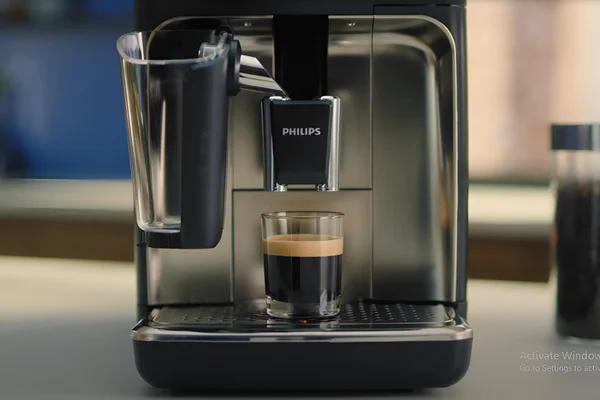
Philips’s weak espresso is because its brewing unit uses baskets with too big holes in it.
You can see this by comparing Philips’s brewing unit’s basket to the Delonghis’ (all the manufacturers’ super automatics use the same brewing unit.
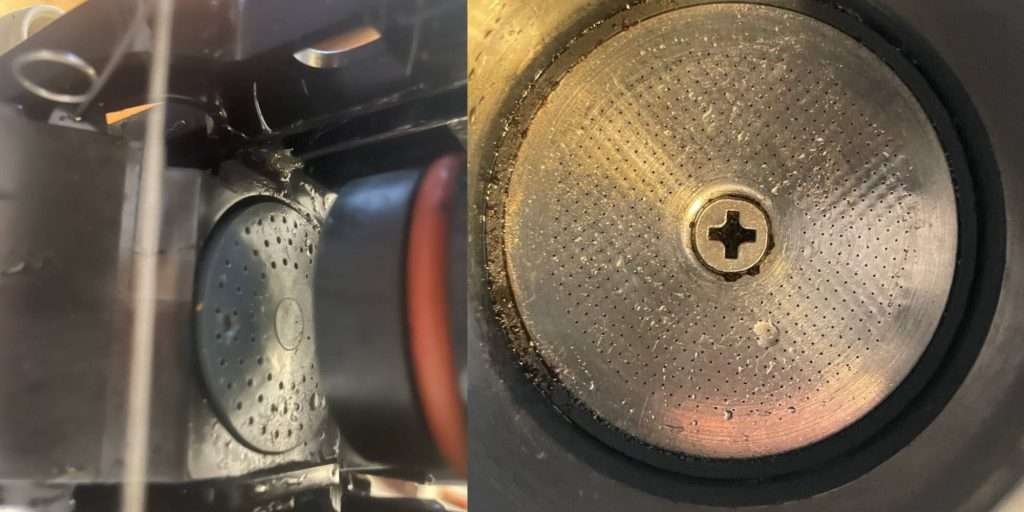
These holes are what provide resistance to your brewing water and ensure that it has adequate direct contact time with your ground coffee for proper extraction to occur.
Espresso should be brewed in 25-30 seconds to give your ground coffee enough time to extract into your brewing water.
The Philips 5400 LatteGo typically brews an espresso in 12-15 seconds. This lack of extraction is why its espresso is so weak,
The machine’s drip-style coffee is better than espresso. The machine grinds and brews your drip coffee in three stages which throttles this brewing process.
Espresso Rating: ⭐⭐⭐ 5/10
Milk Steaming Performance
The Philips 5400 LatteGo steams your milk to a nice thick texture. It can only froth milk to one texture, however, so there is little variation between your milk drinks.
One YouTube reviewer likened the Philips 5400 LatteGo’s milk froth to the “stiff peaks” you aim for when beating egg white into meringue.
In my experience, this is a bit of an exaggeration, but its steamed milk is a lot thicker than the silky microfoam you’d expect from a coffee shop latte.
Still, its milk texture is pretty uniform, especially in its latte and latte macchiato. All but the biggest coffee snobs would find these drinks acceptable.
Its milk-based coffee drinks are certainly better than its black coffee drinks.
Milk Steaming Rating: ⭐⭐⭐⭐ 7/10
User Friendliness
The Philips 5400 LatteGo is one of the most user-friendly super-automatic espresso machines on the market.
This excellent usability is because of its superb user interface and the machine having four user profiles.
These four user profiles mean that anyone can make whatever drink you want with just two to three button presses.
The machine also has a “stop” button which means you can easily cancel out a drink if you make a mistake. This has saved me from overflowing my cup on more than one occasion.
Ease of Use Rating: ⭐⭐⭐⭐ 8/10
Ease of Cleaning
The Philips 5400 LatteGo is one of the easiest super-automatic espresso machines to keep clean.
Fully automatic espresso machine’s two biggest causes of mess are:
- Rubber milk tubes: These crust with milk and are a nightmare to clean because they have tiny holes to push water through.
- Seemingly random rinse cycles: These often catch you off guard and flood your drip tray because you have not put a cup under your spout.
Fortunately, the Philips 5400 LatteGo does not have/do either of these. This alone makes it one of the easiest super-automatic espresso machines to keep clean.
The machine has rinse and brew group clean functions that you can access in its settings menu.
The only manual cleaning that you need to do with the Philips 5400 LatteGo is:
- Emptying its used coffee grounds container and putting it in the dishwasher (every few days).
- Washing its drip tray (every few days).
- Taking out and rinsing its brew group (once a week).
Ease of Cleaning Rating: ⭐⭐⭐⭐⭐ 10/10
Design and Durability
The Philips 5400 LatteGo feels cheaply built, especially considering its price tag.
The entire unit is made out of plastic, with its bean hopper and drip tray particularly feeling nasty to the touch (it reminds me of touching a McDonald’s Happy Meal toy).
The machine’s flimsy feel makes me think that it’s not going to last much longer than its two-year warranty.
At least you can open up the machine to manually lubricate its brew group and unblock any clogages. This should (hopefully) extend the machine’s usable lifespan.
Design and Durability Rating: ⭐⭐⭐ 5/10
Value for Money
The Philips 5400 LatteGo doesn’t offer the best value for money.
It’s only good value if you value ease of use above drink quality and you are going to make full use of its user profiles.
You can get the Philips 4300 LatteGo for around $200 less than the 5400 and it’s basically the same machine with fewer user profiles.
You can get the Delonghi Dinamica for around $200 more than the Philips 5400 and it creates better espresso and milk drinks.
Value for Money Rating: ⭐⭐⭐ 6/10
Philips 5400 LatteGo Review: How it Compares vs. Other Philips Super Automatic Espresso Machines
Philips manufactures four super-automatic espresso machines with their LatteGo milk system: 2200, 3200, 4300, and 5400.
These machines differ in the following ways:
- Your number of menu items
- How far you can customize each drink’s strength and size
- The machine’s user interface
- The machine’s number of user profiles
- The machine’s price (as numbers go up its price typically goes up by $200).
The table below shows how these machines differ. They are listed from cheapest to most expensive:
| Machine Name | Black Drink Options | Milk Drink Options | User interface | User Profiles |
|---|---|---|---|---|
| Philips 2200 LatteGo | 2 | 1 | Buttons only | None |
| Philips 3200 LatteGo | 3 | 2 | Buttons only | None |
| Philips 4300 LatteGo | 5 | 3 | Button operated TFT screen | 2 |
| Philips 5400 Lattego | 7 | 5 | Button operated TFT screen | 4 |
The two best value-for-money Philips espresso machines are the Philips 4300 LatteGo and the Philips 3200 LatteGo.
Further read:
Get the 4300 if you are happy to pay $200 extra for a digital display screen and the 3200 if you’d rather not pay the premium and have a button-only control panel.
If you’d like to find out more about these machines please see my Philips 3200 LatteGo review and Philips 4300 LatteGo review.
Philips 5400 LatteGo vs Delonghi Dinamica
The Delonghi Dinamica makes better espresso and milk drinks than the Philips 5400 LatteGo. The Dinamica is harder to use and keep clean than the Philips.
So your choice between the two machines should really hinge on whether you value drink quality or convenience.
If drink quality is more important to you then get the Delonghi Dinamica.
Philips 5400 LatteGo Review: Final Thoughts
I only recommend the Philips 5400 LatteGo if you want an espresso machine for a large household or office of people who want to drink milk-based drinks.
The machine is about as easy to use and clean as it gets and can make a decent latte. Its plain espresso is inferior to Delonghi super-automatic espresso machines, however.
Best for Large Households and Offices
The Philips 5400 LatteGo’s four user profiles and ease cleaning makes it the ideal coffee machine for larger households or offices.
Buy if:
You’ll make full use of its four user profiles.
You primarily drink milk based drinks.
You are buying a super-automatic espresso machine for an office.
Don’t buy if:
You’ll mainly drink plain espresso
You’re willing to spend a bit more than $1,100 for a better performing espresso machine.
If you’d like to find out what other super-automatic coffee machines are out there please see my roundup of the best super-automatic espresso machines under $1,000.
